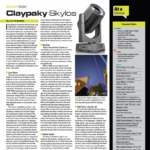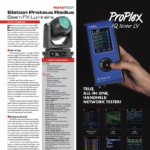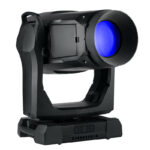The problem with new technology and gear is that you usually only get to put your hands on it the day before a gig, or worse, actually on the gig. I’ll admit — under duress is usually the best way to learn a piece of gear, but not exactly the most stress-free activity in the world. So I was delighted to be able to get my hands on the Barco HDX W20 Flex actually in a shop and not under any time gun or a client breathing down my neck.
The Barco HDX W20 Flex is one of the most popular projectors in a long line of large venue, professional grade rental/staging projectors, and I was lucky enough to preview it in a shop that had six to choose from, so with the help of Eric Lee of Markey’s Rental & Staging, we slapped a lens in and off we went. About the lens — this projector is compatible with the entire line of TLD and TLD + line of Barco lenses, so take your pick. If you already have an inventory of them, bonus!
First Impressions
The Flex is deceiving at first glance. You have the word “20K” in your head and unboxing it reveals what surely is only a 6 or 8K. It is extremely small and lightweight (110 pounds), housed in its rugged steel chassis and optional rigging fly-frame. The optional fly/stack frame is perhaps the easiest-to-stack version I’ve seen, with the addition of well-designed locking feet/cup modules. It’s capable of 360° orientation around the lens-forward center axis, but try not to exceed 15° either side of left/right or you can induce lamp flicker.
 After hooking up a video test generator and power (208V), the internal clock in my head registered something insane like 18 seconds until I saw a test pattern onscreen (I didn’t actually time it….it’s just an ingrained “video guy” trait that crops up all the time). The other thing that struck me was how quiet this unit is, clocking in at just 53 dB.
After hooking up a video test generator and power (208V), the internal clock in my head registered something insane like 18 seconds until I saw a test pattern onscreen (I didn’t actually time it….it’s just an ingrained “video guy” trait that crops up all the time). The other thing that struck me was how quiet this unit is, clocking in at just 53 dB.
Jumping onto the side mounted control/card area yields an extremely bright, clear LCD screen and menu section. There are number of function buttons of the sealed, tactile dome-type as well as space for expansion cards. This unit was equipped with DVI Dual-link and 3G Dual HD-SDI, but there are expansion cards available for 5-wire BNC, 3D with Sensio input, Wi-Fi and even a cell phone adapter (you know…for phoning the gig in).
There are a number of COM ports available — Ethernet, RS232 and 422, USB, as well as DMX IN/THRU. This bodes well for connecting to a multitude of consoles, media servers, and other devices.
One of my favorite ports is a 5-pin XLR on the front, right next to the lens housing. This is for adding a Catalyst mirror head (shoot video all over the room!) or other device…like a douser, color wheel, lens device, or rigging frame leveling device. HD-SDI was the flavor of the day, though, so we started to send some test patterns.
All lens/projector functions are visible on the LCD display as well as the screen you’re shooting on, so this makes it extremely easy to start tweaking in the signal without having to squint or use binoculars (but you should still use those anyway…just good practice.)
The optic processing train uses three .96” DMD’s at 1900×1200 native but will accept up to 2048. All input is sent through Barco’s Athena processing — built in. It’s basically like having an ImagePro onboard, so no more worrying about the speed or quality of scaling/converting downstream.
Menu navigability is well-thought-out, and I never had to go more than three or four button pushes deep to get what I wanted. A side note on this — all of the adjustable parameters are available through Barco’s Projector Toolset, a free download for IOS or Android. Simply connect the projector to an AP, and off you go! Multiple snapshots are available to speed the configuration process, and full control over all parameters is there.
I was not able to hook all this up in this test run, so I can’t attest to the ease of use, but Eric assured me is was dead easy. He used six of these on a recent NCAA mapping gig and controlled all of the PJ’s using the app on his phone.
You can also use the included remote — the really capable, ruggedized remote. It’s obviously designed for pros and built to withstand abuse. Rubber all around and a pop-out 3-pin XLR (or mini-jack) make it universal. There is also 3D support through an optional expansion card with inputs from DisplayPort and HDMI (HDCP enabled).
 “Light On Demand”
“Light On Demand”
The really big feature, however, is what Barco calls “Light on Demand.” The projector’s lamp is tunable from 10 to 20K lumens (in 2K increments), although I was able to see a noticeable difference when using a much more granular measurement (that is, finer than 2K). Another side note — you can set an AutoDim level so the projector will auto-dim to a set level when no signal is present.
What this means is that rental consultants can spec a 10K or 14K and send out just this unit. If a client wants a 16K, so be it. Send this unit, and you don’t have to worry about rental inventory depletion of specific units.
That’s all fine and good for the bean counters, but the projectionist in me screams “Why run a PJ at anything less than it’s capable of?” Eric offered up the first answer. “It’s really nice when you’re in a ballroom or dark theater tweaking a multiscreen blend to not have to look at a screaming projector for two or three hours, not to mention saving on lamp life.”
Point well taken. If you’re on a corporate gig with long standby times between sessions, you can run the lamps at minimum and ramp them up when need be. It doesn’t seem like much, but you could increase the uptime for the PJ’s significantly over time.
I can also imagine being on a multi-screen install, working for a company that has a dozen or so of these in rotation, and getting three or six that have radically different lamp hours. You can tweak all of them to the lowest common denominator and keep a client happy (while you’re frantically phoning the shop for new lamps).
Perhaps the coolest feature of all (probably the most insignificant to most except the true technicians) is the 12V output on the main card. You could wire up an adapter and power an SDI DA up in the truss instead of running an entirely separate 120V line!
Lean and Bright
Light and small is great, but light and small with muscle is everything. Think Sunbeam Tiger for muscle cars or Manny Pacquiao in boxing. Everything about this projector is top-notch. I was extremely impressed with the ease of use, set up, weight, advanced features and overall construction of this projector, and as a technician in the field, I can appreciate these things more than most. As a rental company, you would be well advised to look into purchasing this projector as your next “anchor” piece of projection gear.
Reach Jeff Gooch, a.k.a. Projectionfreak, at www.projectionfreak.com.
At a Glance
Light, Lean and Versatile
Weighing in at a trim 110 pounds – about 35 pounds less than Manny Pacquiao – the HDX-W20 Flex still packs a punch, with an effective reach that extends beyond Pacquiao, Floyd Mayweather, and a few high-rolling ringside ticket holders combined. “Light on Demand” turns this 20K unit into 10K, 12K, 14K, 16K and 18K units for optimum versatility.
PROS: Compact, quiet, bright, versatile, with lots of I/O port, expansion card and lens options. 5-pin XLR near lens housing adds to the array of uses and effects, and all lens/projector functions are visible on the LCD display as well as the screen you’re shooting on.
CONS: If all you really need is a 10K projector, this isn’t your cheapest option
SPECS
- Size: 18.70” x 28.54” x 14.96” (WxLxH)
- Weight: 110 lbs.
- MSRP: HDX-W20 Touring Kit: $72,800



